From Puebla to Oaxaca on the trail of La Carrera Panamericana in a Mercedes SLS AMG – Click above for high-res image gallery
With the increasingly well-publicized progression of drug wars, ransomings, robberies and, well, murders in Mexico, I thought it sensible to familiarize myself with the various government tourist advisory messages ahead of a trip retracing part of the route of La Carrera Panamericana, the famed Mexican road race that ran from 1950 to 1955. Regarded by many as the toughest and most dangerous race ever to take place, the perils of our run down memory lane were likely to be rather different than what was encountered in the '50s. Here are some excerpts of what we were told to expect:
• "Toll (cuota) highways should be used whenever possible, rather than less secure free (libre) roads, where armed robberies and carjacking are more frequent."Thankfully for you, dear reader, we aren't terribly proficient at heeding warnings, so a Mercedes-Benz invitation to borrow their spanking new (and clearly utterly inconspicuous) gullwing SLS AMG supercar and drive it through Mexico at a high rate of speed seemed downright reasonable and prudent. It also appeared to be an absurd amount of fun. Follow the jump to find out how it all shook out.
• "Large fire fights have taken place in many towns and cities across Mexico."
• "U.S. citizen visitors are encouraged to stay in the well-known tourist areas."
• "Mexican styles of driving and road safety standards are very different from those in North America. Police do not regularly patrol the highways. Be prepared for vehicles that fail to observe speed limits or indicate lane changes, and that do not stop at red lights."
• "Thefts occur regularly. You should dress down, avoid wearing or carrying expensive jewelry, and carry only small amounts of cash... try to blend in."
• "Be careful accepting food, drinks, invitations or rides from strangers or recent acquaintances."
• "Road conditions vary and can be poor in some areas. Dangerous curves, poorly marked signs and construction sites, roaming livestock, slow-moving or abandoned vehicles, and other obstacles pose hazards."
• "You are also strongly advised against borrowing a vehicle... drivers are legally responsible for their vehicle's contents, as well as for the legal status of passengers and the items carried by passengers."
Photos by Mercedes-Benz | Chris Paukert / Copyright ©2010 Weblogs, Inc.
Having winged my way from Detroit to Mexico City and traveled by shuttle to the event's starting point of Puebla with a brace of fellow journalists, we checked into our rooms at the hotel and gathered in the courtyard for a few local beverages and to ponder what lay ahead.
Remembering Why We're Here
Before recounting our own Central American odyssey, a bit of a historical primer is in order: The 2011 Mercedes SLS AMG might drip with technology, but it also reeks of nostalgia for the original 300 SL, a prototype of which won the third installment of the Carrera Panamericana Mexico back in 1952 at the hands of Karl Kling and co-driver Hans Klenk. The dynamic duo covered over 1,933 miles at an average speed of 165.011 km/h – that's 102.54 mph – winning the race in little more than an (admittedly artfully sculpted) upturned aluminum bathtub shrouding some production sedan bits with a pair of plaid fabric lawn chairs stuck through. It's the sort of triumphantly masculine feat that can't help but leave a man questioning his own intestinal fortitude and brand of machismo. It's also the sort of blinding historical light that you can't help but want to see and touch for yourself. Which, thanks to Mercedes, we got the chance to do.
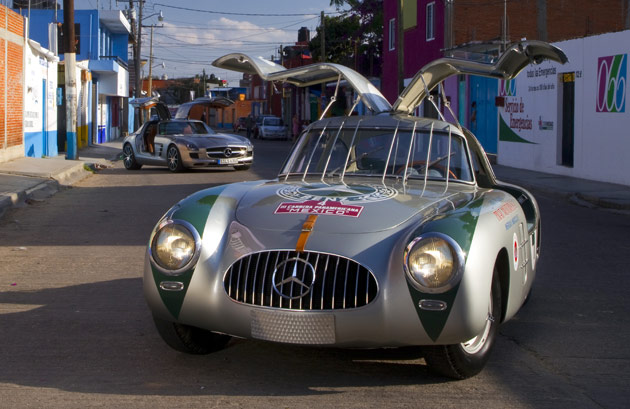
Note: If there's a more appropriate or moving sight for international racing fans than seeing the original W194 racer (shown above) returned to Mexico's roads after being driven off its perch in the MB Museum in Stuttgart, well, we're not sure what that is. On second thought, it might be hearing Indianapolis-born John Fitch, the first American to race for Mercedes-Benz after World War II, recount his own Carrera Panamericana tales while sitting with the car in the sparse beauty of a 15th century Oaxacan convent. But we're getting a bit ahead of ourselves...
Oaxaca, one of Mexico's southernmost states, was to mark the endpoint for our high-speed run through history, with our rolling cabal poised to travel from the more centrally located Puebla via SLS AMG. Our route had been chosen by Mercedes' officials more for its historical correctness than for its picturesque beauty – much of the road network that made up the northern portion of the Panamericana is long gone – but fortunately for us, the drive would provide both in equal measure.
An Unexpected Dignitary
As we sit around drinking and pondering what lies ahead, I am randomly assigned a leadership role in our expedition. Being of ethnically ambiguous origin (for the record: half-Japanese, half-Czech) and in possession of a Van Dyke beard, slightly darker-than-average skin and thick, black hair, Mark Vaughn (senior editor of AutoWeek) decides that I can pass for a local – particularly when wearing the sort of opaque sunglasses that Mexico's often relentless sunlight requires. He nicknames me "El Presidente" and begins fashioning a political tale that's equal parts brutal conquest and "man of the people." Other auto scribes and Mercedes reps within earshot pick up the baton, and for the trip's duration, I am referred to as "His Excellency," "Your Eminence," and so on. Several vie openly and shamelessly for the coveted title of Minister of Propaganda in my cabinet.
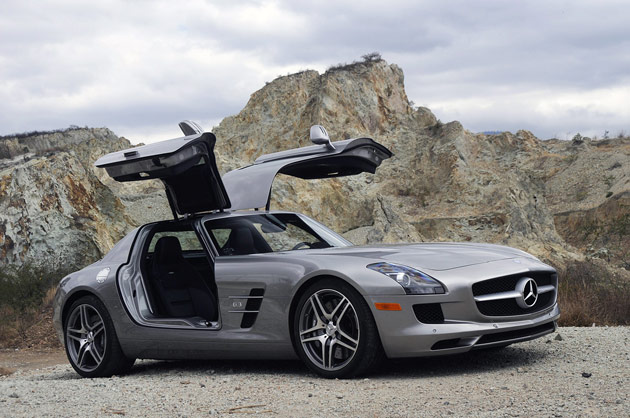
Having gone to college for social relations and government studies, I briefly allow myself to ponder a life viewed from the back seat of a Maybach Landaulet (along with the inevitable mescal-soaked rooms in Los Pinos), but the cold reality of the nation's unspeakable poverty, a local newspaper peppered with stories of drug cartel violence and the throaty burble of the SLS AMG's 6.2-liter V8 lurking outside the hotel reminds me that I'd rather have a life campaigning automobiles from the front seat. I also don't speak much Spanish beyond "Cerveza, por favor," a wrinkle that some feel could prove problematic in my rise to power. Motor journalist it is.
Puebla Exodus
The crack of Monday brings with it another chance to see what life would be like as head of state, as Daimler has curried favor with the local constabulary who have appeared with their Dodge Chargers in considerable numbers on the street outside of our hotel in Puebla's central historic district. The sight of Los Federales is a welcome one, not because we fear for our safety, but more stemming from concern for the pricy aluminum flanks of our SLS AMG armada. The low-sitting, wide-carriage supercars are inherently ill-suited to the city center's heavily trafficked, narrow cobblestone streets and blind 90-degree intersections. The roadway squeeze play is worth it though, if only to hear the thunderous barks and pops from our cars' dual exhausts. They sound simply sensational caroming off the ancient city's constricted, building-lined streets. Even at low speeds, our SLS' soundtracks have local necks craning out of pastel-colored doorways and balconies in confused admiration. Italian automakers may have their own unforgettable soundtrack with the Castrati wails of their V12 engines, but there's equal praise to be doled out for a free-breathing, well-hung V8 like that which resides under the long hood of the SLS.
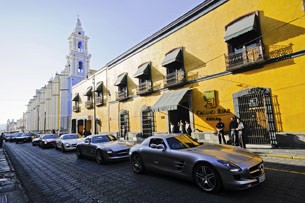
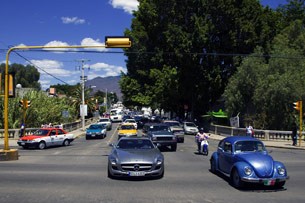
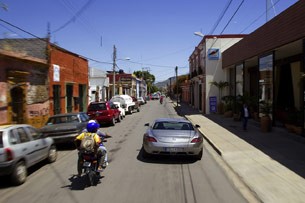
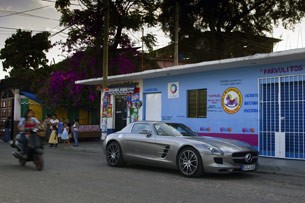
What follows is a gloriously ridiculous – by turns hilarious – and utterly memorable breakout from the city's core by our team, with a surprisingly effective flashing-lights escort and road blocking masterclass by our new Federales friends (who appear to be having as much fun as we are). Passing by impressive centuries-old churches and vibrant open-air markets, we nervously and quickly dice it up with traffic that seems to be composed of roughly 80-percent Nissan Tsuru sedans in varying states of decay – most of them taxicabs. Better known in America as the 1991-1994 B13 Sentra, Nissan has apparently succeeded the Volkswagen Beetle as Mexico's chief purveyor of cheap and hardwearing transportation. Enthusiasts take note: the car that spawned the legendary SE-R is still available locally brand-new.
Cuota Fuego
Upon successfully navigating Puebla and heading out on the open expanses of the cuota, we've been told to expect our Hemi-helming guides to drop off, their missions accomplished. Only thing is, they don't. In fact, after we thread our way through the toll plaza (and the team of identically-dressed salesmen and women who swarm the queue offering everything from food and toys to cigarettes through motorists' open windows), Los Federales' Chargers burst from their blocks and power deep into triple-digit territory before we can even get a fix on the road conditions.
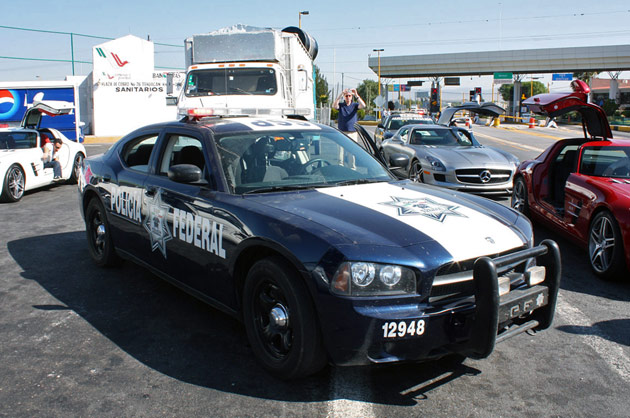
With the joy of this unexpected hunter-becoming-the-hunted role-reversal readily apparent, I uncork the SLS' 563-horsepower taps and set off in pursuit of the police. As we accelerate hard away from the plaza, a wide smile emerges on my face and that of my copilot – expressions of joy that refuse to dissipate for hundreds of miles. Even with Puebla's substantial 7,200-foot altitude (at 5,280 feet, Denver seems downright subterranean in comparison), the naturally aspirated V8 still feels appropriately burly, and a few moments later, we're passing the authorities at an indicated 130 miles-per-hour, wondering for a moment if we aren't pressing the extent of our newfound diplomatic immunity too much. Considering the overtaken Charger is doing in excess of 120 mph, we decide we're on safe ground and pull away, taking advantage of the thin traffic and largely decent road conditions while we have them.
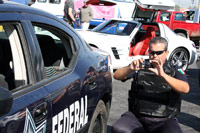

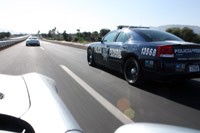
One doesn't normally think of highway driving as being a good test of steering feel and accuracy, but in this case, it is. While the surfaces are better than we expected, there's no getting around the fact that tires as fat as our SLS' Continentals are eager to tramline on poor surfaces, and the front end of our silver streak bobs and weaves like Hugo Sanchez on a breakaway goal attempt. Still, the front, mid-engined SLS offers the best road feel we've experienced in a modern Mercedes, and even with the surface's many imperfections, the rack-and-pinion system's accuracy never shakes the driver's confidence or allows the SLS to wander out-of-lane. Even at high speeds on unfamiliar roads, there are no white knuckles to be found.
Beware the Gullwinged Vultures
As we blast along straight stretches at speeds up to double the posted limit in air-conditioned comfort, I have a moment to ponder the jail-like octet of steel bars bolted over the race-winning 1952 300 SL's windscreen and how they got there. As the story goes, Kling and Klenk were busting along at speeds more modest than ours (around 120 mph) on the race's opening stage when they disturbed a committee of roadside vultures with their car's unmuffled exhaust. The irked birds took flight, with one hitting the Benz's passenger-side windscreen, nearly taking off Klenk's head in the process. When the badly bleeding navigator came to after a moment's unconsciousness, he famously ordered Kling to press on and maintain his pace. Klenk wouldn't get the chance to survey the extent of the damage to his face or his racecar until a tire change some 43 miles later. I quietly praise the robustness of modern tempered glass and am momentarily sad they don't build racing heroes like Klenk anymore.
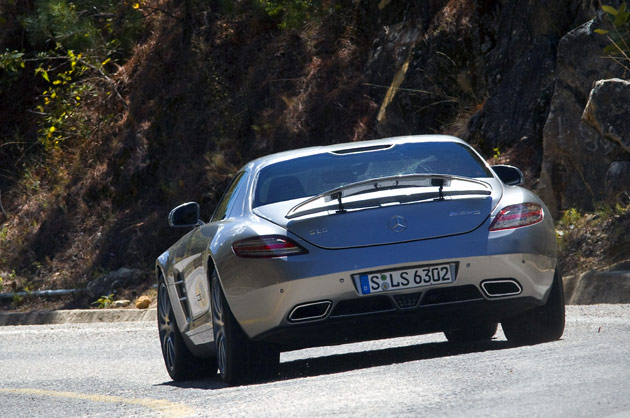
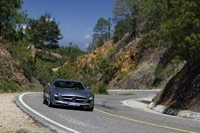
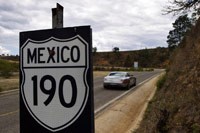
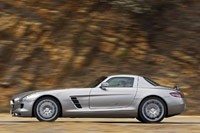
Upon exiting the cuota in favor of Route 190, we get the chance to exercise the SLS on a whooping good piece of winding mountain road, passing through hillsides carpeted in otherworldly finger cacti that poke out of the dry, sandy earth like misplaced ancestors of those giant tubeworms that thrive in deep sea hydrothermal vents. We encounter free-roaming burros just off the apex of steep guardrail-less drop-offs, doddering asthmatic semi trucks that slow our progress (some of whom don't seem to care that they've got the Federales on their backs urging them to make way), and wonderfully sleepy little cantinas in places that are less towns and more unincorporated wide spots in the road. Even well out of our element, we feel welcome and surprisingly at home in these locales that have likely changed little since the Panamericana was run in the '50s.
Guilt Tripping
The truth is, though, journeying through major cities like Puebla and the countless rural, hard-luck towns that would follow in something as spectacular as the SLS, it's impossible not to have moments where one feels like a stereotypical Ugly American, parading through a foreign land unannounced in a blatant leather-lined bubble of speed and privilege. But at brief lay-bys for photographs and pauses out of both human and mechanical sympathy (refueling via tasty mystery meat tacos and Pemex, Mexico's state-owned gas station chain, respectively), we are inundated with warm smiles from appreciative onlookers, many of who produce camera phones and gesture for permission to sit inside while their friends take snapshots.
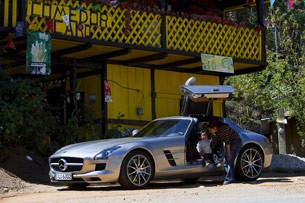
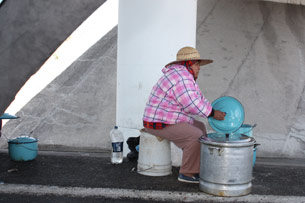
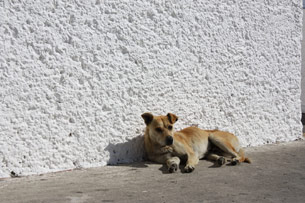
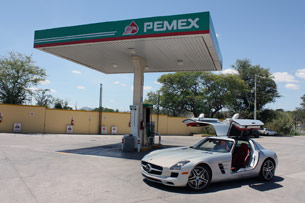
It's worth noting that one can't help but feel that a Maybach Zeppelin or Rolls-Royce Phantom could never stimulate the same sort of open-armed enthusiasm as our theatrically-doored SLS. A long-held personal theory holds up to yet another test: Judging by every nation and precinct I've ever had the pleasure of visiting, worshiping at the supercar temple appears to be a damned-near-universal pastime. In these dark days of global financial and environmental pressures, that's cause for celebration.
Giving the Sleeping Policemen a Close Shave
Interestingly, for the duration of our entire trip, we observe exactly zero lawmen clocking speeders. It is unclear if this is normal, or merely because all of the officers in question are otherwise engaged with our little celebration. As it turns out, speeds are actually well controlled in cities and small towns alike, thanks largely to the omnipresent and often mammoth speed bumps ("topes") that are seemingly everywhere in populated areas off the freeway.
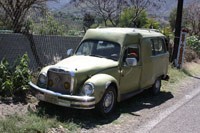
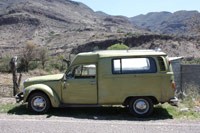
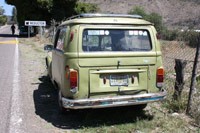
As supercars and speed bumps get along like dogs and thunder, these impediments are frankly a nightmare for the SLS, which doesn't have a front end that can be manually raised by the driver (as on the Lamborghini Gallardo, say). We are forced to gingerly crawl over the majority of these "sleeping policemen" diagonally, one wheel at a time at something less than a walking pace. With most of the bumps, we actually have to inch across at such severe angles that we end up crossing the road's centerline, much to the amusement of the oncoming traffic that have slowed to deal with the hazards themselves. On one occasion, teeth are gnashed as a couple of gasp-inducing scrapes are heard. We're guessing that the original Panamericana participants were never forced to endure these sorts of indignities.
Mountaineering
Once the traffic clears and we've got big stretches of mountain road to ourselves, the long-hooded SLS feels surprisingly at home, with us having switched the gearbox from "Sport +" to "M" for full manual mode and its sub-100-millisecond cogswaps. Not wanting to become part of the scenery but still looking to give it the beans, we leave the stability control on ESP Sport, which allows for much higher performance thresholds before the silicon trickery magically intercedes in the brake and throttle. Even when the ESP does kick in, it's a model of restraint and subtlety, refusing to extinguish both our progress and fun. Out here, we thought perhaps we might overtax our car's steel brake setup (the SLS we drove on our first drive in California was equipped with optional carbon-ceramic stoppers), but they remained fade-free throughout our trip. We suspect the bullion-hued optional units are a good bet for trackday regulars, but the standard setup is clearly up to a proper thrashing.
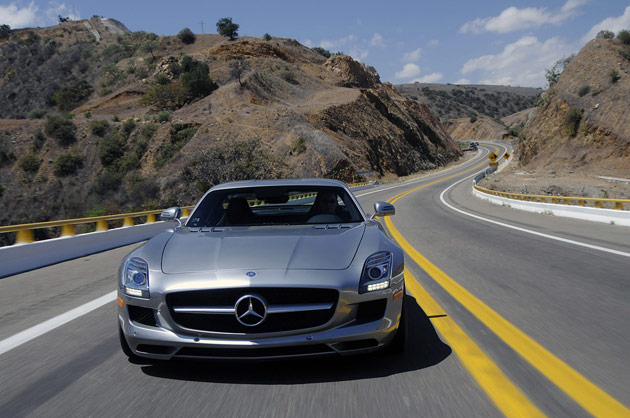
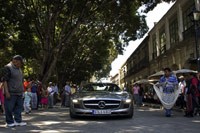
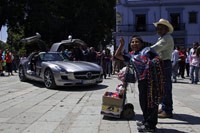
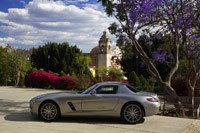
Despite the long and exhilarating drive (and a missed direction or two) we arrive at our hotel in Oaxaca's stunningly beautiful historic center with energy to spare, a testament to the SLS' grand touring abilities. Despite the high-speed nature of our travels, we also arrive with newfound respect and admiration – not only for the SLS AMG and those Panamericana pioneers who helped build the Mercedes gullwing legend that made it possible, but also for the majesty and hospitality of our host country as well.
Back to the Future
Given that the SLS is very much a product of the company's racing history, at the conclusion of our journey, Mercedes not only took the opportunity to introduce us to John Fitch and the aformentioned 1952 300 SL, they gave us an exclusive first look at their SLS AMG GT3 racecar ahead of its New York Auto Show unveiling. It's an impressive looking beast and figures to proudly carry the gullwing torch back into international motorsports.
While there are no plans to place the SLS back into the world of road-based competition at present (there is a continuation series that runs under the Panamericana name, after all), perhaps we'll be chasing down a new set of ghosts and legends in another 58 years. The only thing is, El Presidente can't wait that long to return to Mexico.
Photos by Mercedes-Benz | Chris Paukert / Copyright ©2010 Weblogs, Inc.

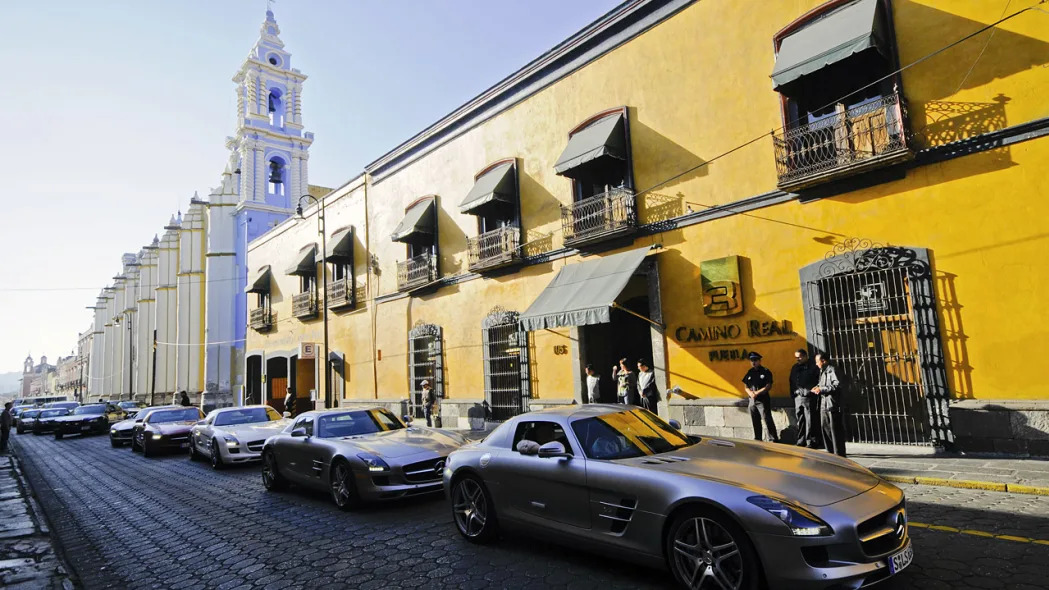

Sign in to post
Please sign in to leave a comment.
Continue